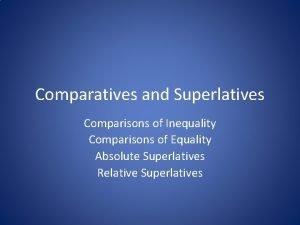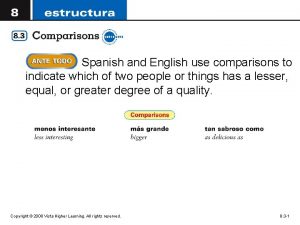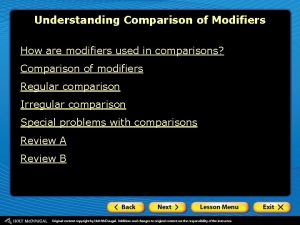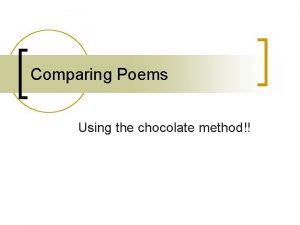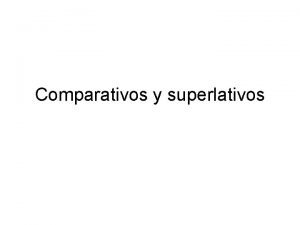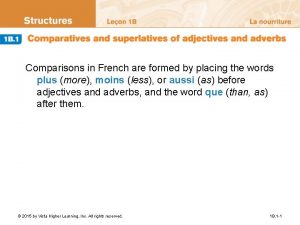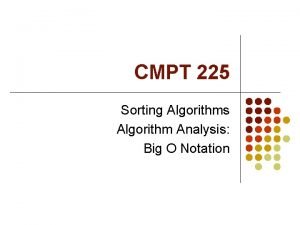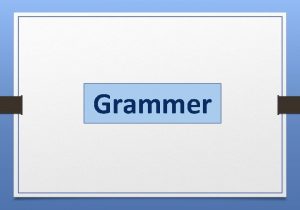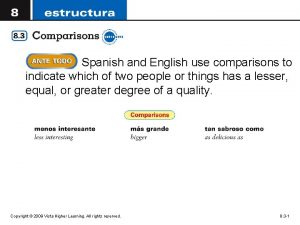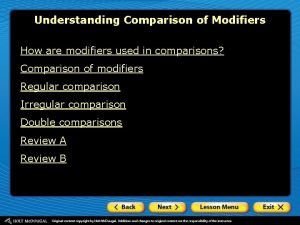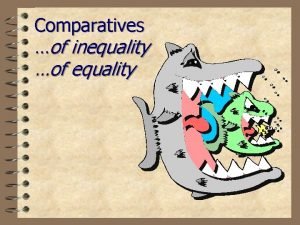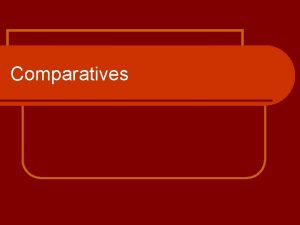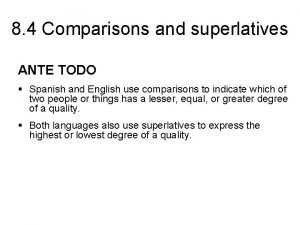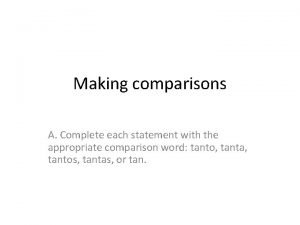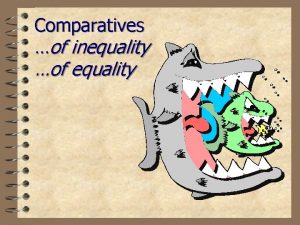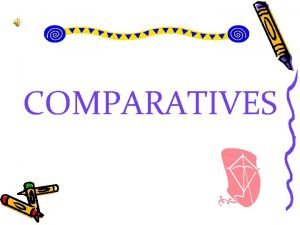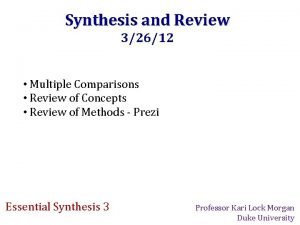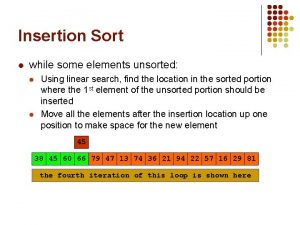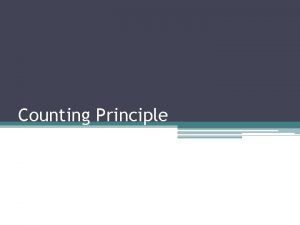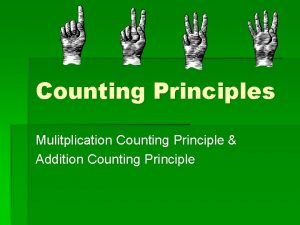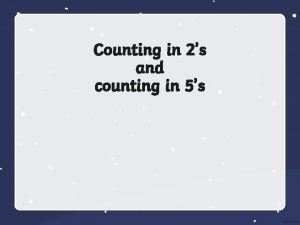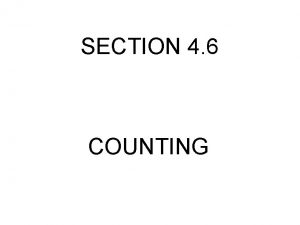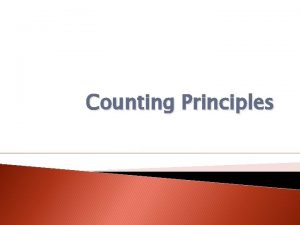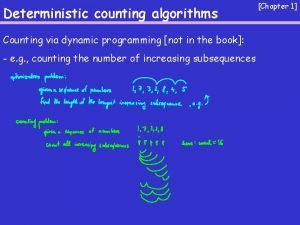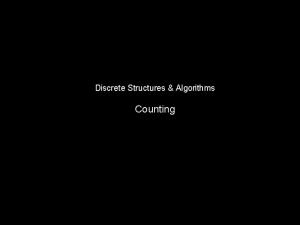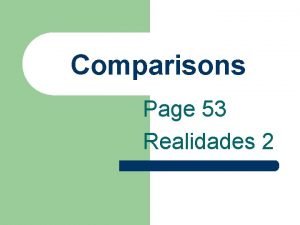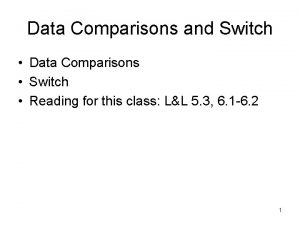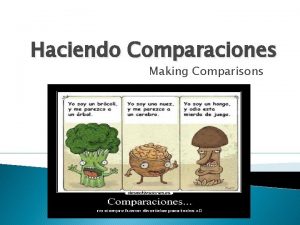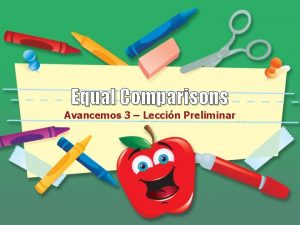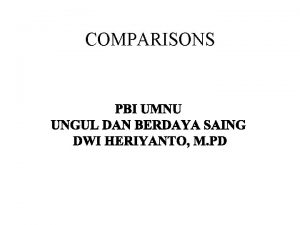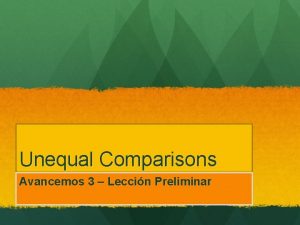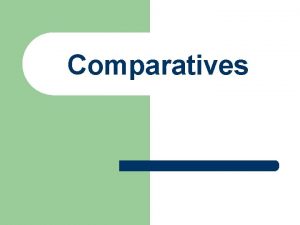Counting Counting in Algorithms How many comparisons are



































- Slides: 35

Counting

Counting in Algorithms • How many comparisons are needed to sort n numbers? • How many steps to compute the GCD of two numbers ? • How many steps to factor an integer?

Counting in Games • How many different configurations for a Rubik’s cube? • How many different chess positions after n moves? • How many weighings to find the one counterfeit among 12 coins?

Sum Rule A B If sets A and B are disjoint, then |A B| = |A| + |B| • Class has 43 women, 54 men, so total enrollment = 43 + 54 = 97 • 26 lower case letters, 26 upper case letters, and 10 digits, so total characters = 26+26+10 = 62

Product Rule Given two sets A and B, the Cartisean product If |A| = m and |B| = n, then |A B| = mn. A = {a, b, c, d}, B = {1, 2, 3} A B = {(a, 1), (a, 2), (a, 3), (b, 1), (b, 2), (b, 3), (c, 1), (c, 2), (c, 3), (d, 1), (d, 2), (d, 3) } If there are 4 men and 3 women, there are possible married couples.

Product Rule: Counting Strings The number of length-4 strings from alphabet B : : = {0, 1} = |B B B B| = 2 · 2 · 2 = 24 The number of length-n strings from an alphabet of size m is m n.

Example: Counting Passwords How many passwords satisfy the following requirements? • between 6 & 8 characters long • starts with a letter • case sensitive • other characters: digits or letters L : : = {a, b, …, z, A, B, …, Z} D : : = {0, 1, …, 9}

Example: Counting Passwords

At Least One Seven How many # 4 -digit numbers with at least one 7?

Defective Dollars A dollar is defective if some digit appears more than once in the 6 -digit serial number. How common are nondefective dollars?

Defective Dollars How common are nondefective dollars?

Generalized Product Rule Q a set of length-k sequences. If there are: n 1 possible 1 st elements in sequences, n 2 possible 2 nd elements for each first entry, n 3 possible 3 rd elements for each 1 st & 2 nd, … then, |Q| = n 1 · n 2 · n 3 · … · nk

Example How many four-digit integers are divisible by 5?

Permutations A permutation of a set S is a sequence that contains every element of S exactly once. For example, here all six permutations of the set {a, b, c}: (a, b, c) (a, c, b) (b, a, c) (b, c, a) (c, a, b) (c, b, a) How many permutations of an n-element set are there?

Permutations How many permutations of an n-element set are there? Stirling’s formula:

Combinations How many subsets of r elements of an n-element set?

Combinations How many subsets of r elements of an n-element set?

Poker Hands There are 52 cards in a deck. Each card has a suit and a value. 4 suits 13 values (♠ ♥ ♦ ♣) (2, 3, 4, 5, 6, 7, 8, 9, 10, J, Q, K, A) Five-Card Draw is a card game in which each player is initially dealt a hand, a subset of 5 cards. How many different hands?

Example 1: Four of a Kind A Four-of-a-Kind is a set of four cards with the same value. How many different hands contain a Four-of-a-Kind?

Example 2: Full House A Full House is a hand with three cards of one value and two cards of another value. How many different hands contain a Full House?

Example 3: Two Pairs How many hands have Two Pairs; that is, two cards of one value, two cards of another value, and one card of a third value?

Example 4: Every Suit How many hands contain at least one card from every suit?

Binomial Theorem

Binomial Theorem

Proving Identities

Finding a Combinatorial Proof A combinatorial proof is an argument that establishes an algebraic fact by relying on counting principles. Many such proofs follow the same basic outline: 1. Define a set S. 2. Show that |S| = n by counting one way. 3. Show that |S| = m by counting another way. 4. Conclude that n = m.

Proving Identities Pascal’s Formula

Combinatorial Proof

More Combinatorial Proof

Sum Rule If sets A and B are disjoint, then |A B| = |A| + |B| A B What if A and B are not disjoint?

Inclusion-Exclusion (2 sets) For two arbitrary sets A and B A B

Inclusion-Exclusion (2 sets) How many integers from 1 through 1000 are multiples of 3 or multiples of 5?

Inclusion-Exclusion (3 sets) |A B C| = |A| + |B| + |C| – |A Ç B| – |A Ç C| – |B Ç C| + |A Ç B Ç C| A B C

Inclusion-Exclusion (3 sets) From a total of 50 students: How many know none? How many know all? 30 know Java 18 know C++ 26 know C# 9 know both Java and C++ 16 know both Java and C# 8 know both C++ and C# 47 know at least one language.

Inclusion-Exclusion (n sets) sum of sizes of all single sets – sum of sizes of all 2 -set intersections + sum of sizes of all 3 -set intersections – sum of sizes of all 4 -set intersections … + (– 1)n+1 × sum of sizes of intersections of all n sets
 Mikael ferm
Mikael ferm Comparison of adjectives and adverbs
Comparison of adjectives and adverbs Internet price comparisons
Internet price comparisons Social comparative and superlative
Social comparative and superlative Priori comparison
Priori comparison Comparisons of equality spanish
Comparisons of equality spanish Modifier comparative and superlative
Modifier comparative and superlative Planned comparisons
Planned comparisons Poems with comparisons
Poems with comparisons Equality and inequality ejemplos
Equality and inequality ejemplos Comparisons in french
Comparisons in french Cmpt 225
Cmpt 225 Comparisons of adjectives and adverbs
Comparisons of adjectives and adverbs Parallel structure with comparisons
Parallel structure with comparisons Is comparison a figure of speech
Is comparison a figure of speech Tú eres (less) simpático que federico.
Tú eres (less) simpático que federico. Modifiers of comparisons
Modifiers of comparisons Quantifiers to make comparisons
Quantifiers to make comparisons Equality adjectives
Equality adjectives Old comparatives
Old comparatives Post hoc vs a priori
Post hoc vs a priori Superlative de cratered
Superlative de cratered Comparisons with as...as
Comparisons with as...as Comparative superlative good
Comparative superlative good Capitulo 1b making comparisons
Capitulo 1b making comparisons Comparatives equality
Comparatives equality Realidades 2 capitulo 1b making comparisons
Realidades 2 capitulo 1b making comparisons Comparisons with as
Comparisons with as Comparatives of equality and inequality español
Comparatives of equality and inequality español A lot far much comparative
A lot far much comparative Equal comparisons
Equal comparisons Xkcd jellybeans
Xkcd jellybeans Form the degrees of comparisons
Form the degrees of comparisons Images to make comparisons
Images to make comparisons Insertion sort big o notation
Insertion sort big o notation Unary many to many
Unary many to many



